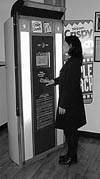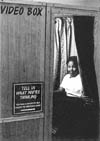Fall 1999
A Soapbox for the Common Person & Tell Us What You Are Thinking
By Pat Ford
Pew Center

A young man, all in black, with hair moussed into a wild halo, wants to talk about homelessness. Another, dressed in suit and tie, wants to talk about parking meters and how “they wait there ’til the meter is just about to expire so they can write you a ticket.”
Next, a couple peers from your TV screen, arms around each other, smiling sweetly. “Hi, I’m Ken Moore,” says the man. “And I’m Moira Moore,” says the woman. They look at each other. Ken beams back into the camera, “And we really want to have a baby.”
These are some of the moments recorded by a videobox, the newest way to get stories and opinions of ordinary people onto television. Video boxes are small, portable TV studios that require no crew, and they could soon be coming to a public place near you.
Developed a decade ago at City TV in Toronto, the boxes are beginning to flourish in the United States since City TV began licensing the technology earlier this year. Stations in Oakland, Portland, Phoenix and 20 other cities have recently licensed boxes to use as news-gathering or promotional tools. City TV is also exporting the boxes to Africa, South America, the Middle East and Europe.
Separately, public station KCTS-TV in Seattle recently took its own version of a video box to nine U.S. cities to gather material for both a regular, half-hour, documentary show on diversity and for a series of short spots that will be distributed nationally by the Public Television Outreach Alliance. (See “Tell Us What You Are Thinking”, below.)
What’s most exciting, say station reps using video boxes, is the sense of power the boxes give to people who speak into them and the level of honesty – even intimacy – the boxes elicit.
“What we’re selling is a cultural phenomenon,” says Ian Schamandy of YOUtv, Inc., the City TV partner that is distributing video boxes. “We’re democratizing television. TV is essentially an elitist tool. Few people have access to the power of TV. [Video boxes] give ordinary people access to that tool.”
Schamandy says that more than a thousand people a week visit City TV’s video box, called “Speaker’s Corner,” built into a corner of its building in Toronto. Visitors talk about the day’s issues but they are also free to talk about anything on their minds. The video is compiled into a half-hour weekly show and dropped into other City TV programming, such as the music video show, “Much Music.”
Men have proposed marriage from the box, stand-up comedians have pitched their acts, musical groups have been discovered. Schamandy says the novelty band “Bare Naked Ladies” got its break when the players crammed into the “Speaker’s Corner” booth and performed a humorous send-up of the booth itself.
On the serious side, he says, Canada’s Prime Minister went to “Speaker’s Corner” during the last election campaign and urged people to vote, regardless of who their candidate was.
“It’s a soapbox for the common person,” says Schamandy, “but a lot of people use it because they see it as a credible way to get out a message.”
The power of the boxes, Schamandy says, is that it gives the person who pushes the “record” button complete control of the process. There is no interviewer or cameraman directing them. That, he says, allows them to be unusually candid.
“People lose their inhibitions when they talk to a machine,” he says. “They say the most incredible things. And you see their body language and feel their emotions. It’s a more visceral process. And it’s amazing entertainment. It’s great television.”
That is precisely what appealed to Craig Miller, advertising and promotion manager for KPDX, a Fox television station in Portland, Oregon, that plans to begin using video boxes this fall. Miller says he first saw “Speaker’s Corner” three years ago during a visit to Canada and thought it would be a wonderful tool for his station. So he jumped at the chance to license the boxes when City TV began exporting them through YOUtv.
“To be a good local station,” says Miller, “we need to reflect what the whole market is thinking and we’ll do that by getting local people to speak their minds and have opinions.”
Fox station, KTVU in Oakland, California, is among the first to use the boxes in the United States. Creative services director Steve Poitras says KTVU put up video boxes, labeled “Fox Box,” in four locations last March.
Poitras says the box is gathering material for the station’s two-hour morning newscast but KTVU also uses it as a promotion tool (with such prompts as “Tell us what you like best about our news shows.”) and as a sales tool.
“Clients will pay a premium to have the box at a location that will drive traffic to their business,” says Poitras. In fact, he says, the busiest location is a Virgin Records megastore in downtown San Francisco.
The boxes are triangular-shaped, fiberglass structures, about six-feet tall. People who venture inside find themselves looking at a TV monitor on which their image appears. Graphics on the screen give simple operating instructions. Questions appear on the screen; the speakers push a button to begin recording and have a brief time to answer the questions or simply say what’s on their minds.
Schamandy says some of the most interesting material has come from video boxes in other countries. In Venezuela, for instance, he says a woman held up a picture of her baby and said, “My baby was sold to rich people. Can you help me?”
YOUtv gathers material from video boxes around the world, packages it and sends it back to stations that use the boxes. That gives stations the chance not only to gather local perspectives on an issue but also to compare them with the comments from people nationally and internationally.
“We really see this as more than just a commercial venture,” says Schamandy. “It’s satisfying to give people the opportunity to be heard because, when you do that, they grab it.”
Tell Us What You Are Thinking
By Pat Ford
Pew Center
It looks a bit like an old-fashioned photo booth: A plain wooden box with a curtain across the entrance. Inside, there’s a seat with a swatch of velvet background and a glass window that shields a camera.
“Tell us what you’re thinking,” says a sign outside.
And people do. Boy, do they.

Seattle public television producer Peggy Case compares “The Box,” (as KCTS-TV simply calls it) to a modern-day confessional. “We never get to see people alone,” she says, “especially in the media. People are directed; they’re made into sound bites. But inside “The Box,” it’s just like meeting someone. They’re careful and pleasant and not too revealing at first but, as time goes on, they begin to embrace the camera and relate more of their hopes and dreams and the darkest parts of their history.”
Unlike the “Speakers’ Corner” video boxes developed by City TV in Toronto, KCTS-TV’s Box does not so much ask for opinions as it seeks self-reflection.
All alone inside, visitors are prompted with a very general question that invites a very personal response. “What is your first memory?” for example. Or “What are you afraid of?”
“What we’ve observed is that, no matter what the age group or economic class, after a brief period of time self-consciousness fades away and people begin to speak freely,” Case says. “The point is to get people to digress.”
The monologues are often startlingly intimate. A young woman respond to a general question about love with a general answer: “When you’re in love with someone, it doesn’t matter what they do to you. Just knowing they’re alive is good.”
But as the camera remains fixed on her, she continues: “I was in love. (Pause) I still am. (Pause) We almost got married. (Pause) We’re not together now. But I still love him. (Pause) Here I am, a peep-show girl, talking about love.”
Exploring people’s inner worlds is only part of Case’s goal in deploying “The Box.” She also wants to challenge the preconceptions of viewers. So she takes “The Box” to places about which viewers are likely to have already formed opinions.
The “peep-show girl,” for example, was a stripper at a bar called “The Lusty Lady,” where “The Box” sat for a day. Case took “The Box” to a Catholic girls’ school, a female juvenile offenders detention center, and a hospice.
Case recently took “The Box” to several locations to make drop-in segments for public television stations participating in the Outreach Alliance project on diversity. “The Box” went to a senior center in St. Louis, Grand Central station for the morning rush, the Special Olympics, an Indian reservation and a Texas rodeo. Case says she was most fascinated by video gathered at Gallaudet, a university for the deaf and hard of hearing in Washington, D.C., where visitors used sign language for the camera.
“The thing that’s interesting,” says Case, “is the way people react to emotional questions. People everywhere have the same feelings.”
Case thinks “The Box” could be a valuable tool for getting at public issues in a new way during the upcoming presidential campaign. For instance, to explore Americans’ feelings about health care, “The Box” could record people in a hospice or hospital – someplace where the issues impact people directly.
“What we’re telling people,” says Case, “is that what they have to say, alone, is valuable and important and needs to be heard.”
